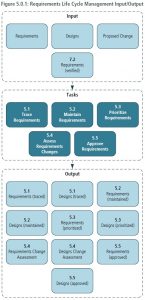The Business Analysis Core Concept Model™ (BACCM™) describes the relationships among the six core concepts. The following table describes the usage and application of each of the core concepts within the context of Requirements Life Cycle Management.
Table 5.0.1: The Core Concept Model in Requirements Life Cycle Management
| Core Concept | During Business Analysis Planning and Monitoring, business analysts… |
| Change: the act of transformation in response to a need. | manage how proposed changes to requirements and designs are evaluated during an initiative. |
| Need: a problem or opportunity to be addressed. | trace, prioritize and maintain requirements to ensure that the need is met. |
| Solution: a specific way of satisfying one or more needs in a context. | trace requirements and designs to solution components to ensure that the solution satisfies the need. |
| Stakeholder: a group or individual with a relationship to the change, the need, or the solution. | work closely with key stakeholders to maintain understanding, agreement, and approval of requirements and designs.
|
| Value: the worth, importance, or usefulness of something to a stakeholder within a context. | maintain requirements for reuse to extend value beyond the current initiative. |
| Context: the circumstances that influence, are influenced by, and provide understanding of the change. | analyze the context to support tracing and prioritization activities. |

The Requirements Life Cycle Management knowledge area includes the following tasks:
- Trace Requirements: analyzes and maintains the relationships between requirements, designs, solution components, and other work products for impact analysis, coverage, and allocation.
- Maintain Requirements: ensures that requirements and designs are accurate and current throughout the life cycle and facilitates reuse where appropriate.
- Prioritize Requirements: assesses the value, urgency, and risks associated with particular requirements and designs to ensure that analysis and/or delivery work is done on the most important ones at any given time.
- Assess Requirements Changes: evaluates new and changing stakeholder requirements to determine if they need to be acted on within the scope of a change.
- Approve Requirements: works with stakeholders involved in the governance process to reach approval and agreement on requirements and designs.
Chapter 5: Requirements Life Cycle Management pg. 79
